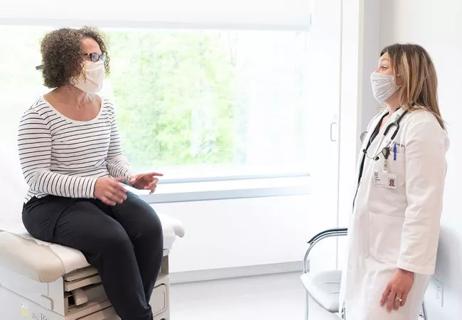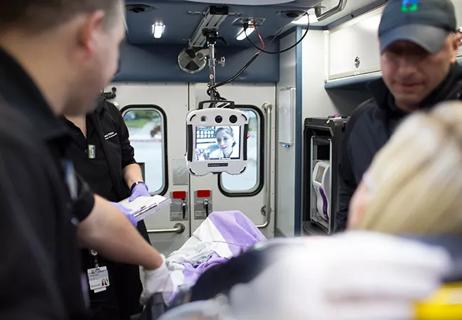Dr. Jeffrey Cohen says changes streamline diagnosis and extend scope to new populations

The 2010 McDonald criteria for diagnosis of multiple sclerosis (MS), the specialty standard in research and clinical practice, were recently revised by the International Panel on Diagnosis of Multiple Sclerosis. Jeffrey Cohen, MD, of Cleveland Clinic’s Mellen Center for Multiple Sclerosis Treatment and Research, co-chaired the international panel, and chaired the International Advisory Committee on Clinical Trials in MS for the past six years. Last October, he presented an overview of the revised criteria at the 7th joint ECTRIMS-ACTRIMS meeting in Paris, and now the criteria have been published in full by Lancet Neurology.
Cleveland Clinic is a non-profit academic medical center. Advertising on our site helps support our mission. We do not endorse non-Cleveland Clinic products or services. Policy
Consult QD recently interviewed Dr. Cohen (shown with a patient above) on key features of the 2017 revisions of the McDonald criteria.
Dr. Cohen: The most significant revision is that cerebrospinal fluid (CSF) results can now be used to diagnose MS under appropriate clinical circumstances. The old criteria required demonstrating that patients had lesions disseminated in space and time clinically or by MRI. The new criteria allow for a diagnosis to be made in a patient with a single attack and confirmation of dissemination in space based on clinical or MRI evidence if the CSF is positive for two or more oligoclonal bands.
The other revisions are really refinements:
Dr. Cohen: Several other potential revisions were debated, but we ended up opting against those changes because of insufficient data. The most contentious issue surrounded incorporating optic nerve involvement into the criteria. While optic nerve involvement is an important feature of MS, diagnostic sensitivity and specificity of MRI, visual evoked potentials and optical coherence tomography to demonstrate optic nerve lesions and inform the diagnostic criteria were deemed insufficient. This area was identified as a high priority for future research.
Another controversy concerned the number of periventricular lesions required to fulfill MRI criteria for dissemination in space. The 2001 and 2005 McDonald criteria required three or more lesions, and the 2010 McDonald criteria reduced the requirement to one. We considered changing back the required number because a single periventricular lesion is not uncommon in older people and those with vascular disease, including migraines. But changing it back would have reduced sensitivity and only modestly increased specificity.
One other interesting area is “radiologically isolated syndrome” — that is, patients without clinical manifestations of MS but with incidental radiological findings suggestive of it. Many of these patients go on to develop MS and may benefit from early treatment, but without more data, we could not recommend changing the current diagnostic criteria.
Dr. Cohen: New data have emerged since the last revision, including from studies conducted in more diverse populations. The new information goes beyond the North American and western European adults that the 2010 criteria were mostly based on. Additional studies were reviewed from Asia, the Middle East and Latin America, as well as in children. In general, the data support the applicability of the 2010 McDonald criteria in these diverse populations.
However, for children younger than 11 years old, special care in diagnosis is needed, as the likelihood of MS is low.
Dr. Cohen: The panel decided early on to only make changes that were supported by reasonable evidence rather than based solely on “expert opinion.” We weren’t set on making major changes, but rather on simplifying and clarifying the 2010 criteria.
The issue of misdiagnosis was always at the forefront of our discussions. We want patients to have prompt access to appropriate therapies, but we don’t want to get the diagnosis wrong and expose patients to potent anti-inflammatory drugs unnecessarily. Efficiency in diagnosis must be balanced with caution.
The McDonald criteria cannot be viewed as a simple checklist. Ultimately, diagnosis requires expertise. I would urge physicians not to rush to judgment and to obtain more information if the diagnosis is uncertain.

Analysis characterizes geography’s sizable role in urban/rural care divides

New analysis details the disparities and points to opportunities for improvement

In survey, both female and male respondents reporting ongoing concerns

Group advocates for stroke systems of care supported by telestroke and proper reimbursement

Dr. Gregory Nemunaitis looks to build on his history of integrating education, research and patient care

Mission centers on screening, prevention for at-risk women in their 30s to 60s

One-year results from national database confirm enduring benefits

Q&A with Dr. Andrew Russman, Medical Director of our Comprehensive Stroke Center